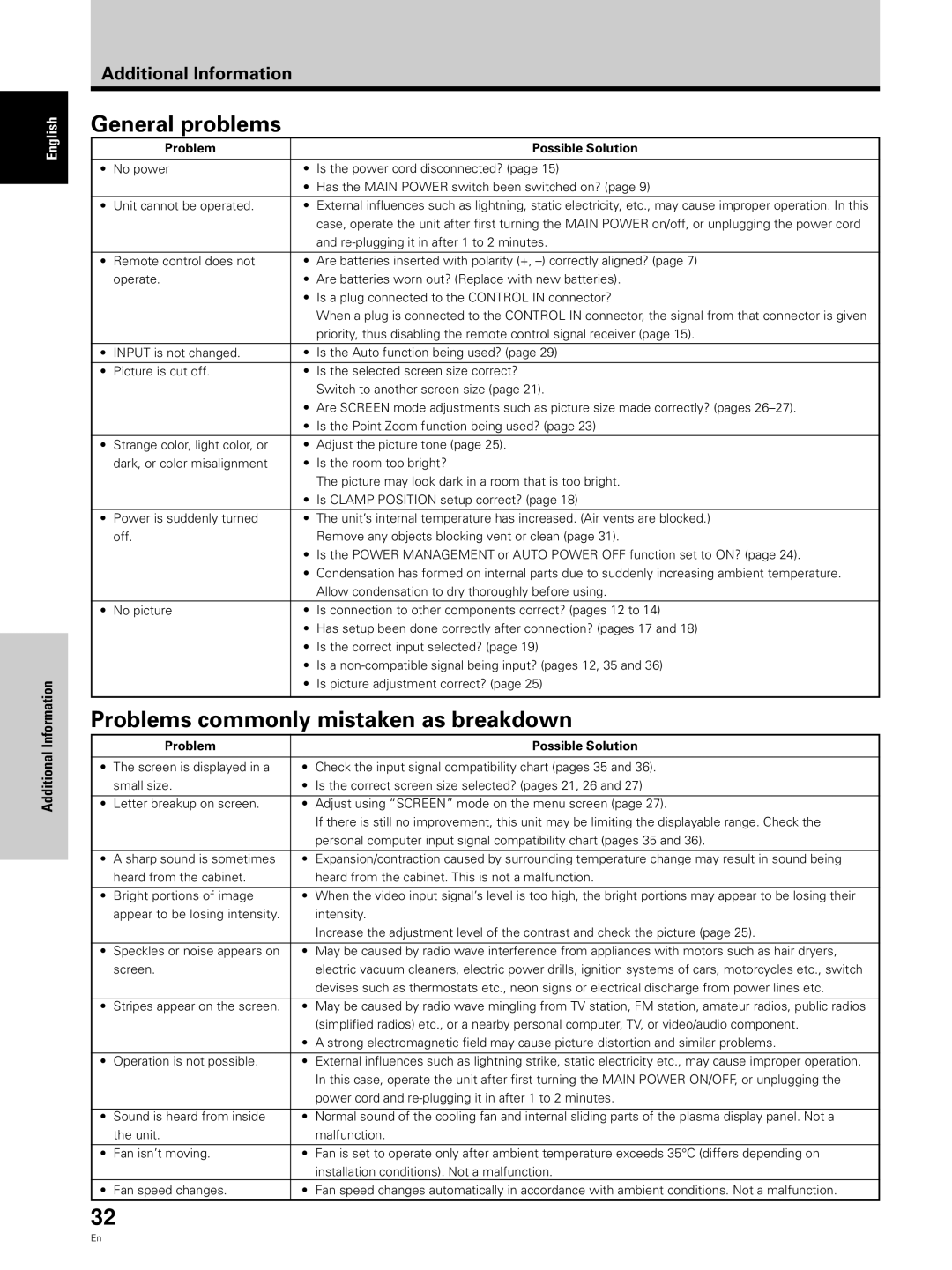
English
Additional Information
Additional Information
General problems
| Problem | Possible Solution |
|
|
|
• | No power | • Is the power cord disconnected? (page 15) |
|
| • Has the MAIN POWER switch been switched on? (page 9) |
• | Unit cannot be operated. | • External influences such as lightning, static electricity, etc., may cause improper operation. In this |
|
| case, operate the unit after first turning the MAIN POWER on/off, or unplugging the power cord |
|
| and |
• | Remote control does not | • Are batteries inserted with polarity (+, |
| operate. | • Are batteries worn out? (Replace with new batteries). |
|
| • Is a plug connected to the CONTROL IN connector? |
|
| When a plug is connected to the CONTROL IN connector, the signal from that connector is given |
|
| priority, thus disabling the remote control signal receiver (page 15). |
• | INPUT is not changed. | • Is the Auto function being used? (page 29) |
• | Picture is cut off. | • Is the selected screen size correct? |
|
| Switch to another screen size (page 21). |
|
| • Are SCREEN mode adjustments such as picture size made correctly? (pages |
|
| • Is the Point Zoom function being used? (page 23) |
• | Strange color, light color, or | • Adjust the picture tone (page 25). |
| dark, or color misalignment | • Is the room too bright? |
|
| The picture may look dark in a room that is too bright. |
|
| • Is CLAMP POSITION setup correct? (page 18) |
|
|
|
• | Power is suddenly turned | • The unit’s internal temperature has increased. (Air vents are blocked.) |
| off. | Remove any objects blocking vent or clean (page 31). |
|
| • Is the POWER MANAGEMENT or AUTO POWER OFF function set to ON? (page 24). |
|
| • Condensation has formed on internal parts due to suddenly increasing ambient temperature. |
|
| Allow condensation to dry thoroughly before using. |
• | No picture | • Is connection to other components correct? (pages 12 to 14) |
|
| • Has setup been done correctly after connection? (pages 17 and 18) |
|
| • Is the correct input selected? (page 19) |
|
| • Is a |
|
| • Is picture adjustment correct? (page 25) |
|
|
|
Problems commonly mistaken as breakdown
| Problem |
| Possible Solution |
|
|
|
|
• | The screen is displayed in a | • | Check the input signal compatibility chart (pages 35 and 36). |
| small size. | • | Is the correct screen size selected? (pages 21, 26 and 27) |
|
| ||
• Letter breakup on screen. | • Adjust using “SCREEN” mode on the menu screen (page 27). | ||
|
|
| If there is still no improvement, this unit may be limiting the displayable range. Check the |
|
|
| personal computer input signal compatibility chart (pages 35 and 36). |
|
|
|
|
• | A sharp sound is sometimes | • | Expansion/contraction caused by surrounding temperature change may result in sound being |
| heard from the cabinet. |
| heard from the cabinet. This is not a malfunction. |
|
|
|
|
• | Bright portions of image | • | When the video input signal’s level is too high, the bright portions may appear to be losing their |
| appear to be losing intensity. |
| intensity. |
|
|
| Increase the adjustment level of the contrast and check the picture (page 25). |
|
|
|
|
• | Speckles or noise appears on | • | May be caused by radio wave interference from appliances with motors such as hair dryers, |
| screen. |
| electric vacuum cleaners, electric power drills, ignition systems of cars, motorcycles etc., switch |
|
|
| devises such as thermostats etc., neon signs or electrical discharge from power lines etc. |
|
|
|
|
• | Stripes appear on the screen. | • | May be caused by radio wave mingling from TV station, FM station, amateur radios, public radios |
|
|
| (simplified radios) etc., or a nearby personal computer, TV, or video/audio component. |
|
| • | A strong electromagnetic field may cause picture distortion and similar problems. |
|
|
|
|
• | Operation is not possible. | • | External influences such as lightning strike, static electricity etc., may cause improper operation. |
|
|
| In this case, operate the unit after first turning the MAIN POWER ON/OFF, or unplugging the |
|
|
| power cord and |
|
|
|
|
• | Sound is heard from inside | • | Normal sound of the cooling fan and internal sliding parts of the plasma display panel. Not a |
| the unit. |
| malfunction. |
• | Fan isn’t moving. | • | Fan is set to operate only after ambient temperature exceeds 35°C (differs depending on |
|
|
| installation conditions). Not a malfunction. |
• | Fan speed changes. | • | Fan speed changes automatically in accordance with ambient conditions. Not a malfunction. |
32
En
